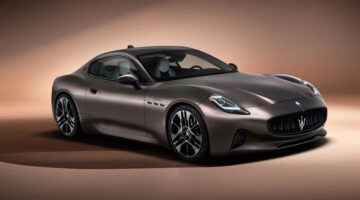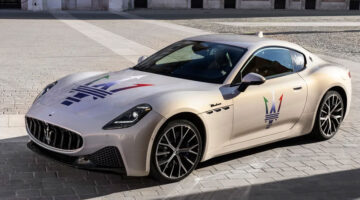The reason for this confusion is that no matter how many times I count them, I still count four doors. So, the new Ghibli is a mid-sized luxury saloon with little relation then to the sporty Ghibli goodness of old? Not quite. Maserati are keen to pimp the sporting credentials of this latest model, but to be honest, I am a little dubious that it will actually have any.
The ‘sporting behaviour of a coupé but with the practicality of a saloon’ is a fine ideal but in practice we all know that means ‘compromise’. The Ghibli we are driving is the 330hp, twin turbo-charged 3.0-litre V6 with rear-wheel drive, and the compromise is obvious. It weighs in at 1810kg.
Despite its 60 percent aluminium upper body and sharing much of the lightweight architecture from the new Quattroporte, it is clear once you step inside where all this added mass comes from. The interior has a luxurious wealth of high quality leather, the seats have sporting pretentions – though the emphasis is on comfort – and even the door cards are palm span deep with a pleasing flat top on which to rest one’s arm. Even starting the damn thing produces a slightly muted engine note in the cabin such is the level of sound deadening. All good for luxury with all boxes ticked but surely a nail in the coffin for any sporting pretensions.
However, with the windows down the distinctive ‘seven notes’ from the Maserati V6 are pure Italian opera. It would therefore follow that if it sounds like Luciano Pavarotti and weighs the same (give or take) as Luciano Pavarotti, then it will probably be as agile as Luciano Pavarotti on the country roads around Siena.
With only a few hours to play with the Ghibli, there is no real time to check out normal mode to use as a comparison. Traction control is neutered and sports mode selected – adding sharpness to the steering and faster operation of the now fully manually operated eight-speed ZF gearbox. A dalliance with the sports suspension option comes to an abrupt halt as it is too stiff for the rough and uneven road surface, and quite surprisingly, the Ghibli is soon tearing around the tight and twisty strada with a sure-footedness that seems contradictory to my admittedly slim grasp of physics.
Once on the move, the Ghibli just doesn’t feel like the heavy saloon it is. The steering is direct, nicely weighted and telegraphs plenty of feedback, though the wheel is a little fat at the 3 o’clock and 9 o’clock positions. There’s great pedal feel with extremely positive progressive braking that mocks the Germanic zeitgeist of over assistance. The full anchor effect is there when you need it but a slight dab to scrub off speed won’t have your face hurtling towards the windscreen.
The Ghibli inspires confidence into corners and backs it up on the corner with perfect 50:50 weight distribution without a hint of understeer. It may be a heavy car but it is superbly balanced. With the traction off, powering out of the corner results in controllable oversteer as the power is transmitted through the mechanical limited-slip differential. And this is when the Ghibli plays its trump card.
The 330hp produced by the 3.0-litre engine is hardly earthshattering but it is backed up by 500Nm of torque that hustles the Ghibli out of the corner with much furious anger and nashing of teeth, coupled with the growling of that throaty Maserati V6 and the sounds of someone giggling. Which I soon realize is me.
I really didn’t expect to like the Ghibli as much as this. On paper it shouldn’t work, yet somehow adds up to become more than the sum of its parts. It combines weighty luxury with real driver involvement. It has a sporty edge and a genuine Maserati personality that doesn’t get lost within the swathes of cowhide, touchscreen technology and acoustic sound deadening.
I still don’t get why they called it the Ghibli though.
| Maserati Ghibli | |
|---|---|
| Engine: | V6 / twin turbo-charged / 2979cc |
| Power: | 330hp @ 5000rpm |
| Torque: | 500Nm @ 4500rpm |
| Transmission: | Eight-speed ZF transmission / rear-wheel drive / mechanical limited-slip differential |
| Front suspension: | Double-wishbone |
| Rear suspension: | Five-arm multilink system |
| Weight (kerb) | 1810kg |
| 0-100kph: | 5.6sec |
| Top speed: | 263kph |



